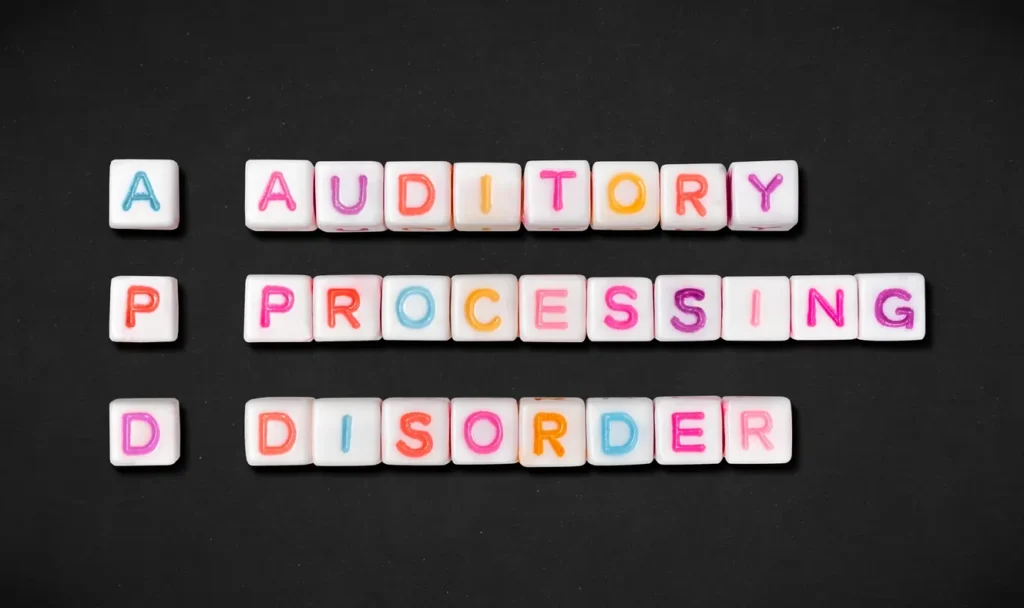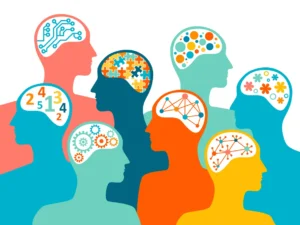
Story At-A-Glance
- Auditory Processing Disorder (APD) involves difficulties with how the brain interprets and makes sense of sounds, despite normal hearing sensitivity in tests.
- The auditory processing pathway involves multiple steps: sound detection by the ears, neural transmission, complex brain processing (involving temporal processing, binaural integration, pattern recognition, discrimination, memory, and attention), and integration with other systems.
- Key signs of APD include difficulty following directions, frequent requests for repetition, better understanding with visual presentation, struggles in noisy environments, and inconsistent responses to auditory information.
- APD is not a single disorder but encompasses several types: auditory decoding deficit, prosodic deficit, integration deficit, auditory associative deficit, and output-organization deficit.
- APD frequently co-occurs with other conditions like ADHD, dyslexia, autism spectrum disorders, and language disorders, creating diagnostic challenges that require comprehensive assessment.
- Evaluation typically involves multiple professionals: audiologists, speech-language pathologists, and educational/neuropsychologists, using various tests and assessments.
- Parents can support children with APD through communication adaptations, creating supportive home environments, building underlying skills through games and activities, and effective school advocacy.
- The transition from elementary to middle school brings unique challenges for children with APD due to multiple teachers, increased memory demands, and more complex environments.
- With appropriate intervention and support, individuals with APD can develop necessary skills and strategies for academic and social success at any age, though early intervention typically yields the strongest results.
- Understanding APD helps children recognize that their struggles stem not from lack of intelligence or effort, but from differences in how their brains process auditory information.
- The brain’s neuroplasticity means that improvements in auditory processing are possible, offering hope and practical pathways forward for affected children and their families.
“My child passed all her hearing tests, but it’s like she doesn’t hear me.”
“He can repeat what I say perfectly one minute, then seem completely confused the next.”
“The teacher says she doesn’t follow directions, but I know she’s smart and trying her best.”
These puzzling observations often point to a frequently overlooked learning challenge: Auditory Processing Disorder (APD). Unlike hearing loss, which involves the ears’ ability to detect sounds, APD involves how the brain interprets and makes sense of what is heard. Children with APD have normal hearing sensitivity but struggle to process auditory information, creating significant barriers to learning, communication, and social interaction that can be frustrating for both children and parents.
Understanding Auditory Processing: Beyond Hearing
To understand APD, we need to recognize that hearing is only the first step in a complex process of extracting meaning from sound.
The Auditory Processing Pathway
Sound processing involves multiple steps and brain regions:
- Sound Detection: The ears detect sound waves and convert them to neural signals (this is “hearing” in the traditional sense)
- Neural Transmission: Signals travel through the auditory nerve to the brainstem
- Auditory Processing: Various brain regions analyze different aspects of sound:
- Temporal processing (timing aspects of sound)
- Binaural integration (combining information from both ears)
- Pattern recognition (identifying sound patterns)
- Auditory discrimination (distinguishing between similar sounds)
- Auditory memory (retaining auditory information)
- Auditory attention (focusing on relevant sounds)
- Integration with Other Systems: Auditory information is integrated with visual, linguistic, and cognitive systems to create meaning
Dr. Frank Musiek, a leading researcher in auditory neuroscience, explains: “The ears are merely the doorway through which sound enters the brain. The real work of making sense of sound happens in various neural networks. When these networks don’t function optimally, a child can hear perfectly well but still struggle to make sense of what they’re hearing.”
Auditory Processing in Learning and Communication
Efficient auditory processing is foundational for:
Language Development: Children learn language by precisely distinguishing speech sounds, identifying word boundaries, and detecting subtle differences in tone and inflection.
Reading Acquisition: The phonological processing skills that underlie reading rely heavily on auditory processing abilities.
Classroom Success: Following directions, engaging in discussions, and learning from lectures all depend on effective auditory processing.
Social Interaction: Understanding conversational nuances, taking turns in conversation, and picking up on emotional cues in speech require sophisticated auditory processing.
Dr. Teri James Bellis, author of “When the Brain Can’t Hear,” notes: “Auditory processing is the ‘software’ that allows us to use our hearing effectively in real-world situations. Without this software functioning properly, even perfect hearing ‘hardware’ cannot support efficient communication and learning.”
Signs and Symptoms: The Many Faces of APD

Auditory Processing Disorder can manifest in numerous ways, often appearing different across children and contexts. Here are key indicators grouped by area:
Listening and Comprehension
- Difficulty following multi-step directions
- Frequently asking “what?” or “huh?” despite normal hearing
- Better understanding when information is presented visually
- Struggle to follow conversations in noisy environments
- Difficulty understanding rapid or accented speech
- Inconsistent responses to auditory information
- Problems identifying where sounds are coming from
Language and Communication
- Delayed language development despite normal intelligence
- Difficulty distinguishing between similar-sounding words
- Problems with phonological awareness (manipulating sounds in words)
- Literal interpretation of language, missing nuances or jokes
- Trouble with verbal problem-solving
- Difficulty expressing thoughts clearly
- Problems learning foreign languages
Academic Performance
- Reading difficulties, particularly with phonics-based approaches
- Poor spelling, especially phonetically irregular words
- Trouble taking notes while listening
- Difficulty remembering material presented verbally
- Inconsistent academic performance
- Challenges with musical concepts and rhythm
- Struggle with oral reading fluency
Behavioral Signs
- Becoming easily distracted by background noises
- Appearing to ignore people when spoken to
- Seeming withdrawn in group settings
- Becoming anxious about situations with complex auditory environments
- Showing unusual sensitivity to certain sounds
- Becoming unusually fatigued after school or social events
- Preferring to play alone or with younger children
A study published in the International Journal of Pediatric Otorhinolaryngology found that approximately 43% of children referred for learning difficulties had significant auditory processing deficits that had not been previously identified.
Types of Auditory Processing Disorders
APD is not a single disorder but a category encompassing several different types of processing difficulties. Understanding the specific type can help target interventions more effectively:
Auditory Decoding Deficit
Characteristics:
- Difficulty distinguishing between similar speech sounds
- Problems understanding speech in less-than-ideal conditions
- Struggle with phonics and sound-symbol relationships
- Reading and spelling difficulties
Real-world impact: A child with an auditory decoding deficit might confuse words like “bat” and “pat” or struggle to follow conversations when there’s background noise, like in a classroom or cafeteria.
Prosodic Deficit
Characteristics:
- Difficulty interpreting tone, stress, and rhythm in speech
- Monotone speech or unusual speech patterns
- Problems recognizing emotions in others’ speech
- Difficulty with reading comprehension despite adequate decoding
Real-world impact: A child might miss the sarcasm in a statement or misinterpret a question as a statement due to missing the prosodic cues that signal the speaker’s intent.
Integration Deficit
Characteristics:
- Trouble integrating auditory information with information from other senses
- Difficulty with tasks requiring coordination of listening and doing
- Problems with reading and writing tasks that require phonics
- May seem disorganized or have poor time management
Real-world impact: A student might struggle to take notes while listening to a teacher or have difficulty following a science experiment with verbal instructions.
Auditory Associative Deficit
Characteristics:
- Difficulty applying meaning to what is heard
- Struggles with higher-level language skills
- Problems with verbal problem-solving
- Difficulty understanding abstract language
Real-world impact: A child might understand all the words in a math word problem but struggle to extract the key information needed to solve it.
Output-Organization Deficit
Characteristics:
- Problems organizing and sequencing responses to auditory information
- Difficulty expressing thoughts clearly
- Problems retelling stories in logical sequence
- Struggle with organizing written work
Real-world impact: A student might understand a story but have difficulty summarizing it or telling it back in their own words in a coherent manner.
APD and Commonly Co-occurring Conditions
APD frequently co-occurs with, and sometimes mimics, other developmental and learning challenges:
APD and ADHD
Approximately 50% of children diagnosed with ADHD also show signs of auditory processing difficulties. The connection appears bidirectional:
- Attention deficits can impact a child’s ability to focus on and process auditory information
- Auditory processing problems can create behaviors that look like inattention
Key distinction: Children with primary APD typically show attention difficulties specifically in listening situations, while those with ADHD show attention issues across multiple modalities and contexts.
APD and Dyslexia
The relationship between APD and dyslexia is complex and significant:
- Both involve phonological processing challenges
- APD can contribute to the phonological deficits seen in dyslexia
- Some researchers see APD as a potential causal factor in certain types of reading disabilities
Key distinction: Children with APD often show broader listening and language comprehension difficulties beyond reading, while those with primary dyslexia may have specific challenges with written language despite good listening comprehension.
APD and Autism Spectrum Disorders
Many children with autism spectrum disorders also have auditory processing difficulties:
- Problems filtering relevant from irrelevant auditory information
- Difficulty integrating auditory information with social context
- Unusual responses to certain sounds or sound patterns
Key distinction: In ASD, auditory processing issues are usually part of broader sensory processing differences and social communication challenges.
APD and Language Disorders
The overlap between APD and language disorders is substantial:
- Both can involve problems with phonological awareness
- Both can impact vocabulary acquisition and grammar development
- Both can affect social communication
Key distinction: Children with primary language disorders typically show difficulties with language content and usage across modalities (speaking, writing, reading), while those with primary APD show specific difficulties with the auditory aspects of language.
Dr. Gail Chermak, professor of audiology, explains: “The frequent co-occurrence of APD with other developmental conditions creates diagnostic challenges but also highlights the importance of comprehensive assessment. Many children have complex profiles that require multidisciplinary approaches rather than single-diagnosis treatments.”
Identification and Assessment: Finding Answers
The Assessment Process
A comprehensive APD evaluation typically involves multiple professionals:
Audiologist:
- Conducts specialized auditory processing tests
- Assesses various aspects of auditory function
- Evaluates how the child processes different types of auditory stimuli
Speech-Language Pathologist:
- Evaluates language processing and production
- Assesses phonological awareness skills
- Examines the impact of auditory processing on communication
Educational Psychologist/Neuropsychologist:
- Assesses cognitive abilities and learning profile
- Evaluates attention and executive function
- Helps differentiate APD from other learning and attentional issues
Key Assessment Components:
- Behavioral auditory tests that assess different auditory processing abilities
- Tests of phonological awareness and other language skills
- Measures of academic achievement, particularly in reading and language arts
- Questionnaires about real-world listening abilities and challenges
- Sometimes, electrophysiological measures that assess neural responses to sound
Dr. Jeanane Ferre, an APD specialist, emphasizes: “No single test can diagnose APD. A comprehensive battery approach is essential to characterize the specific nature of a child’s auditory processing challenges and guide effective intervention.”
Supporting Your Child with APD: Practical Strategies for Parents
Communication Adaptations
Simple adjustments to how you communicate can significantly help children with APD:
Gain Attention First:
- Ensure you have your child’s visual attention before speaking
- Use their name to signal that important information is coming
- Eliminate competing noise sources when possible before important conversations
Adjust Your Speaking Style:
- Speak at a slightly slower rate, but maintain natural prosody
- Emphasize key words through slight stress or volume changes
- Pause between information units or direction steps
- Maintain good face-to-face positioning for visual cues
Confirm Understanding:
- Ask your child to repeat directions in their own words
- Have them explain “what,” “why,” and “how” rather than just acknowledging
- Watch for nonverbal cues that may indicate confusion despite verbal confirmation
- For important information, follow up verbal communication with written notes
Creating Supportive Home Environments
The home environment can be structured to support auditory processing success:
Acoustic Modifications:
- Use soft furnishings to reduce echo and reverberation
- Consider carpet or rugs in learning spaces
- Manage background noise during homework time
- Use white noise machines in bedrooms if environmental noise is disruptive
Organizational Systems:
- Implement visual checklists for routine tasks
- Create designated spaces for important items
- Use visual timers for time management
- Establish consistent routines that reduce reliance on verbal reminders
Technology Supports:
- Use recording features for important family schedules or events
- Implement visual reminder apps
- Consider text-based communication options for complex information
- Explore assistive listening devices for challenging environments
Building Underlying Skills at Home
Parents can supplement formal interventions with home activities:
Auditory Discrimination Games:
- Word and sound categorization activities
- Minimal pair discrimination (“Is this ‘bat’ or ‘pat’?”)
- Direction-following games with increasingly complex steps
- “Simon Says” with carefully structured auditory commands
Phonological Awareness Activities:
- Rhyming games and word play
- Sound segmentation and blending practice
- Syllable counting activities
- Word games that manipulate beginning and ending sounds
Auditory Memory Enhancement:
- Sequential memory games starting simple and increasing complexity
- Audiobook listening with comprehension questions
- Verbal direction games with progressively longer sequences
- Music and rhythm activities that support temporal processing
Strategic Listening Practice:
- Listening for specific information in audiobooks or shows
- Practicing active listening with summarization
- Identifying emotional tone in speech samples
- Sequential storytelling activities
A study in the Journal of Educational Psychology found that children whose parents implemented structured auditory activities at home 3-4 times weekly showed twice the improvement rate compared to children receiving school-based intervention alone.
Looking Forward: APD Across the Lifespan

With appropriate intervention and support, the long-term outlook for individuals with APD is increasingly positive:
Elementary to Middle School Transition
This transition often brings new challenges due to:
- Multiple teachers with different communication styles
- Increased auditory memory demands
- More complex classroom environments
- Greater expectations for independence
Success strategies:
- Gradually increase self-advocacy skills throughout elementary years
- Develop organizational systems that can transfer to multiple classrooms
- Practice note-taking skills before they become critical
- Consider a transition meeting with the receiving educational team
Adolescence and Beyond
As academic and social demands increase, different supports become important:
Academic Considerations:
- Technology becomes increasingly important for compensation
- Strategy use needs to become more self-initiated
- Course selection may need to consider auditory processing demands
- College planning should include consideration of support services
Social and Emotional Aspects:
- Help teens understand the neurological basis of their processing differences
- Support development of self-acceptance and self-advocacy
- Ensure understanding of legal rights and accommodations in higher education
- Encourage exploration of strengths and interests beyond auditory-heavy areas
Dr. Katz, clinical professor of audiology, offers this perspective: “Many adults with auditory processing disorders have found their way to successful careers and fulfilling lives. The key is developing an understanding of one’s processing style and implementing effective strategies. With appropriate identification and intervention, APD should not limit a child’s potential.”
Conclusion: Listening Beyond Hearing
Auditory Processing Disorder represents one of the most commonly overlooked explanations for learning and communication difficulties in children with normal hearing. By understanding that hearing and listening are not the same—that detecting sounds is only the first step in a complex neural process—parents and educators can identify children who are struggling and implement effective supports.
The journey with APD can be challenging, but with appropriate identification, intervention, and support, children with auditory processing difficulties can develop the skills and strategies needed for academic and social success. The brain’s neuroplasticity means that improvements are possible at any age, though early intervention typically yields the strongest results.
Perhaps most importantly, understanding APD helps children recognize that their struggles stem not from lack of intelligence or effort, but from differences in how their brains process auditory information. This understanding itself can be transformative, shifting the narrative from one of personal failure to one of neurodiversity and different learning needs.
For the parent who hears “My child doesn’t listen” in teacher conferences, for the teacher who sees a bright student struggling inexplicably with verbal instructions, and most of all, for the child who works twice as hard to make sense of the auditory world—understanding APD opens doors to more effective support and ultimately, to success.
References
- American Academy of Audiology. (2010). Clinical Practice Guidelines: Diagnosis, Treatment, and Management of Children and Adults with Central Auditory Processing Disorder. American Academy of Audiology.
- American Speech-Language-Hearing Association (ASHA). (2005). (Central) Auditory Processing Disorders [Technical Report]. Available from www.asha.org/policy.
- Bellis, T. J. (2003). When the Brain Can’t Hear: Unraveling the Mystery of Auditory Processing Disorder. Atria Books.
- Chermak, G. D., & Musiek, F. E. (2013). Handbook of Central Auditory Processing Disorder, Volume I: Auditory Neuroscience and Diagnosis (2nd ed.). Plural Publishing.
- Ferre, J. M. (2006). Managing Children’s Central Auditory Processing Deficits in the Real World: What Teachers and Parents Want to Know. Thinking Publications.
- Geffner, D., & Ross-Swain, D. (2018). Auditory Processing Disorders: Assessment, Management, and Treatment (3rd ed.). Plural Publishing.
- Iliadou, V., Ptok, M., Grech, H., Pedersen, E. R., Brechmann, A., Deggouj, N., … & Bamiou, D. E. (2017). A European perspective on auditory processing disorder-current knowledge and future research focus. Frontiers in Neurology, 8, 622.
- Keith, R. W. (2009). SCAN-3
- Tests for Auditory Processing Disorders for Children. Pearson.
- Lucker, J. R. (2015). Auditory Processing Abilities in Children: When to Test? The Hearing Journal, 68(1), 20-24.
- Musiek, F. E., & Chermak, G. D. (2013). Handbook of Central Auditory Processing Disorder, Volume II: Comprehensive Intervention (2nd ed.). Plural Publishing.
- Sharma, M., Purdy, S. C., & Kelly, A. S. (2009). Comorbidity of auditory processing, language, and reading disorders. Journal of Speech, Language, and Hearing Research, 52(3), 706-722.
- Wilson, W. J., & Arnott, W. (2013). Using different criteria to diagnose (central) auditory processing disorder: How big a difference does it make? Journal of Speech, Language, and Hearing Research, 56(1), 63-70.
Note: This blog post is intended for educational purposes only. While the information presented is based on scientific research, individual situations vary. Please consult with qualified professionals for proper assessment and individualized recommendations.



